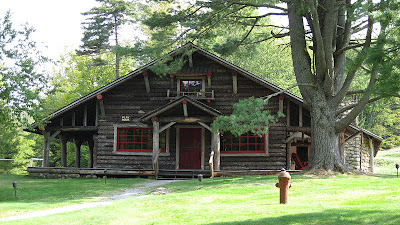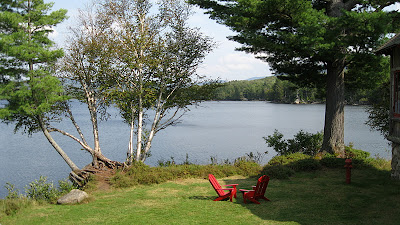Sagamore is one of the more accessible of the surviving camps…and they offer walking tours of this extensive facility.
The Sagamore Camp was built on Sagamore Lake by William West Durant between 1895 and 1897. This was his third camp…he’d already built Camp Pine Knot, (later owned by Collis P. Huntington – railroad developer), and Camp Unicas. (Once owned by J. P. Morgan – financier and banker) Durant was the son of a railroad promoter and financier and William became a property developer who specialized in building the great camps.
Laurie was very busy taking photos of the many structures that comprise the Sagamore Camp’s compound. Many of them are fairly spectacular! The building shown above is in the ‘upper camp’ or worker’s complex. Part of the buildings purpose was to serve as a dormitory for the single men working at the Camp.
Durant got into financial troubles in 1901 and he sold the camp to Alfred Gwynne Vanderbilt. Vanderbilt expanded the compound, adding flush toilets, a sewer system plus hot and cold running water. Later he added a tennis court, a hydroelectric plant, an outdoor bowling alley, a 100,000 gallon reservoir and a working farm… Vanderbilt died nobly in 1915, saving the lives of others before he perished in the sinking of the Lusitania.
This large building is ‘sided’ with bark… These camps were all located on lakes in remote locations and the larger structures were mostly built using logs and locally quarried stone with shingled roofs, overhanging roof lines and large porches. This unique American architectural style was obviously influenced by the Arts & Crafts Movement and by the Swiss chalet design.
When Alfred Vanderbilt died, Camp Sagamore passed on to his widow, Margaret Emerson. She was an avid sportswoman, (and heiress to the Bromo-Seltzer fortune), who continued to use the camp for many years. Eventually, in 1954, she transferred the camp and its 1,526 acres to Syracuse University.
The University operated a conference center here until the State of New York offered to buy it. Since the property was located within the boundaries of the Adirondack Park, and since it would have fallen within the ‘Forever Wild’ provision of the State Constitution, the Preservation League of New York took over the title and the property is now run as a not-for-profit institution.
Unfortunately, Syracuse University had let the camp run down…this is an expensive place to maintain. They logged the land and then sold it all off except for the 7.7 acres occupied by the compound. Worse yet, the University sold off all of the original furnishings…
This was Alfred’s cottage on the property. Like most of the ‘cottages’ in the compound, this was used as a guest cottage and it still is…
To quote from a short history written by Alfred G. Vanderbilt, the original Alfred G. Vanderbilt’s grandson… “I was a small child when I came to camp. What I remember best are the deer walking through the compound to eat from our hands like pets, the sunlight on the main lodge, the mists every morning on the lake, and the atmosphere of fun and enthusiasm that pervaded Sagamore at all times…”
This is the main lodge at Camp Sagamore. During the years that Margaret Emerson was in summer residence, visitors to the camp included such famous names and luminaries as: General George Marshall, Richard Rogers, Howard Hughes, Gary Cooper, Gene Tierney and Madame Chiang Kai-Chek. (‘Madame’ brought 25 personal maids with her on that visit!)
The largest camps were built on very large landholdings. The land was cheap and the buyers were very wealthy. Many of the early camps were built by Jewish families who were excluded from the traditional Adirondack resorts. Such wealthy Jews as Otto Kahn, (financier/railroads), Daniel Guggenheim, (industrialist), and the daughters of the founders of Lehman Brothers purchased land and built Great Camps when they weren’t allowed to join established clubs.
Obviously, the fire escape on the right of this cottage has been added to meet today’s fire safety codes. All of the structures on the property have been very well maintained. This photo and the one before, was where laundry was done.
The use of rustic, native materials and local craftsmen was consistent throughout the era of these Great Camps. Another common feature was the use of separate buildings for separate functions. From dining to sleeping cabins, from bowling alleys to dance pavillions…they were connected by walkways, many of them covered to protect family and guests from the elements.
This is the outdoor bowling alley at Sagamore Camp. Those wealthy folks certainly knew how to spend their money! The return feature for the bowling balls was automated and unique but I can’t recall what the tour guide told us.
Then there was and is the view…the setting for Camp Sagamore. Not too shabby…
The only negative is that this National Historic Landmark is like an empty pinata. The buildings are pretty to look at from the outside but, absent at least of some of their original funishings, one cannot really grasp or appreciate what living in a Great Camp must have been like. Almost all of the charm is on the outside of these great buildings…its like looking at a 4 sided façade.
Despite the lack of furnishings, this was a decent tour with a lot of history to absorb. I don’t really have a ‘bucket list’, but I’d always been curious about these Great Camps. Camp Sagamore is definitely worth a stop if you’re touring the Adirondacks.
The camp is now operated by Sagamore Institute of the Adirondacks, Inc. In addition to the tours, accommodations are offered from May through October. The camp is home to several retreats each year as well as Grands Camps Sundays to Fridays in July and August. These ‘camps’ are designed for grandparents and their grandchildren. Great idea!
Address: Great Camp Sagamore, P.O. Box 40, Sagamore Road, Raquette Lake, New York 13436. Phone: 315-354-5311. For more information to to their Website at: http://www.greatcampsagamore.org/great-camp-sagamore.html.
Just click on any photo to enlarge it…
Thanks for stopping by for a visit!
Take Care, Big Daddy Dave










"Those wealthy folks certainly knew how to spend their money!" - you got that right. Heck you're not even wealthy and Laurie knows how to spent yours.
ReplyDelete